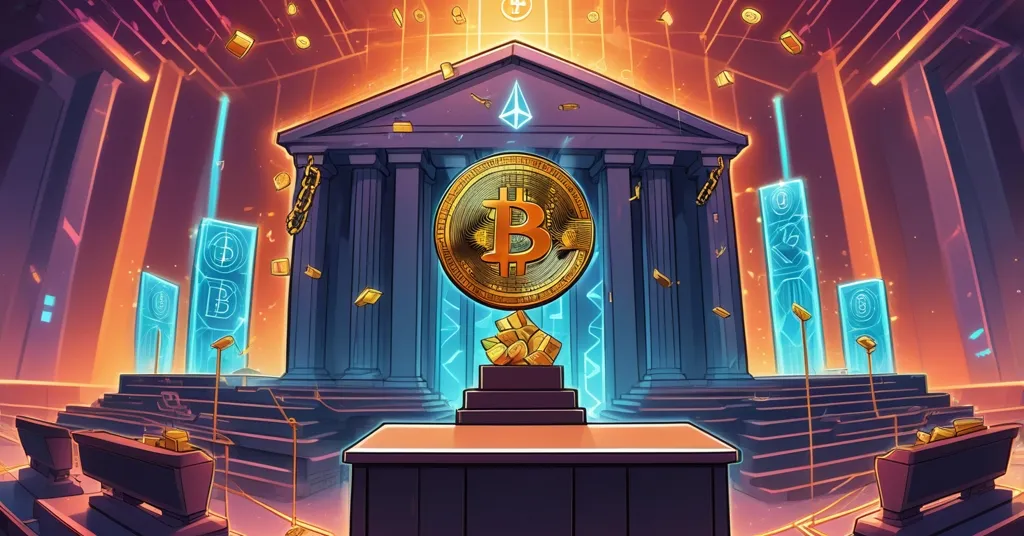SEC Chairman Atkins Redefines Crypto Rules: Most Tokens Not Securities in 2023

SEC Chairman Paul Atkins Shakes Up Crypto Regulation: Most Tokens Not Securities in 2023
A monumental pivot in U.S. crypto regulation is underway as SEC Chairman Paul Atkins, who assumed the role in April, rolls out a far more lenient framework for digital assets. Unlike the relentless crackdowns of his predecessor Gary Gensler, Atkins’ policies could unshackle countless blockchain projects from the suffocating grip of securities oversight, marking a potential turning point for Bitcoin, altcoins, and the broader decentralized finance (DeFi) space.
- New Standards: Tokens classified as securities only if tied to explicit promises and essential third-party managerial efforts.
- Exempted Assets: Ethereum, Solana, XRP, meme coins, and NFTs likely free from SEC jurisdiction.
- Policy Shift: Crypto Task Force formed, prior enforcement dropped, and six-month warning periods introduced.
From Gensler’s Iron Fist to Atkins’ Open Hand
Gary Gensler’s tenure as SEC Chairman was a brutal slog for the crypto industry. Under his watch, nearly every token was branded a security, subjecting projects to a gauntlet of legal battles that drained billions in fees. Heavyweights like Ripple Labs, Terraform Labs, Binance, Coinbase, and Kraken bore the brunt, with Ripple alone reportedly shelling out over $100 million in legal costs. Gensler’s expansive interpretation of securities law—rooted in the idea that most tokens resembled investments reliant on others’ efforts—created a chilling effect, stifling innovation and leaving startups paralyzed by fear of regulatory retribution.
Fast forward to April 2023, and Paul Atkins steps in with a radically different playbook. His appointment signals a departure from the “sue first, ask questions never” mentality. Atkins is narrowing the scope of what qualifies as a security in the crypto realm, arguing that the label should only apply when a token’s value hinges on explicit, unambiguous promises tied to the essential managerial efforts of a third party, as highlighted in recent discussions on new SEC standards for crypto tokens. Think of it like investing in a startup where your returns depend entirely on the founder’s hustle—contrast that with a decentralized token like Bitcoin, where no single entity calls the shots. If there’s no clear promise or centralized control, Atkins says the SEC shouldn’t meddle.
“An asset should only be considered a security in situations where a third party’s managerial efforts are absolutely essential to promises of the asset’s future value.” – Paul Atkins
Why does this classification matter? Being labeled a security triggers a mountain of rules—think mandatory disclosures, investor protections, and registration requirements—that can cripple fast-moving crypto projects with costs and delays. Atkins’ narrower criteria could be a lifeline for the industry, especially for tokens long caught in regulatory crosshairs.
Redefining Securities: What’s In and What’s Out
Under Atkins’ new guidelines, a swath of digital assets stands to escape SEC oversight. Major players like Ethereum, Solana, and XRP—often targeted under Gensler—are likely exempt, as are meme coins (think Dogecoin) and non-fungible tokens (NFTs) used as digital collectibles. Even tokenized tools, like digital tickets or membership passes on a blockchain, should dodge the securities tag. For the uninitiated, Ethereum and Solana are blockchain platforms with native tokens (ETH and SOL) that power decentralized applications (dApps) and smart contracts—self-executing agreements coded directly onto the blockchain. Their utility often transcends traditional investment characteristics, a point Atkins seems to grasp.
However, don’t pop the champagne just yet. Tokenized securities—digital versions of regulated assets like stocks or bonds—remain firmly under the SEC’s thumb. Picture a tokenized Apple stock on a blockchain like Ethereum; despite its high-tech wrapper, it’s still subject to the same old Wall Street rules. Sorry, tokenized Tesla shares—you’re still on the SEC’s naughty list. This distinction means that while many pure crypto projects might breathe easier, hybrid assets blending traditional finance with blockchain tech still face the regulatory gauntlet.
Policy Shifts: Task Forces, Grace Periods, and Dropped Cases
Atkins isn’t just redefining terms; he’s revamping how the SEC engages with crypto. One of his boldest moves is the creation of a dedicated Crypto Task Force, a specialized unit to handle digital asset matters with a more nuanced touch. He’s also taken an axe to Gensler’s legacy by dropping numerous ongoing enforcement actions that had firms bleeding cash in courtrooms. No more ambush lawsuits—at least for now.
Perhaps most refreshing is the introduction of warning notices. Crypto companies flagged for potential violations will get a heads-up and up to six months to rectify issues before the SEC considers enforcement. This grace period is a stark contrast to the previous regime’s “guilty until proven innocent” approach, offering breathing room for firms to adapt rather than collapse under sudden legal pressure.
Super-Apps and Beyond: Atkins’ Vision for Innovation
Atkins’ ambitions go beyond damage control. He’s championing a future where innovation isn’t crushed by red tape, advocating for “super-apps” that could blend trading of securities and non-securities in a single platform. Imagine staking Ethereum, buying a tokenized ETF, and snagging an NFT—all without leaving one seamless app. He’s also pushing his team to explore securities trading on non-SEC regulated platforms, a move that could liberate blockchain-based exchanges from traditional oversight models and turbocharge decentralized finance (DeFi).
“While capital formation should continue to be overseen by the SEC, we should not hamstring innovation and investor choice by requiring the underlying assets to trade in one regulated environment versus another.” – Paul Atkins
This vision aligns with the crypto ethos of dismantling silos, a principle that Bitcoin maximalists and Ethereum innovators can both rally behind. Atkins believes securities laws were meant to address narrow scenarios—cases where investors rely on someone else’s competence and honesty for returns—not to police every new form of digital value.
“Congress crafted the securities laws to address specific problems—situations in which people part with their money based on promises that depend on the honesty and the competence of others. They were not designed as a universal charter to regulate every novel form of value, digital or otherwise.” – Paul Atkins
Risks and Gray Areas: Playing Devil’s Advocate
Before we crown Atkins the savior of crypto, let’s pump the brakes. While his lighter touch sounds like a dream for innovation, it’s not without pitfalls. Gray areas abound—what happens when a token’s promises are vague or “managerial efforts” are tough to pin down in a decentralized setup? Some projects might slip through the cracks as non-securities only to later face scrutiny if their structure evolves. And let’s not ignore history: the 2017-2018 ICO boom proved that less oversight can embolden scammers, leaving naive investors burned by rug pulls and pump-and-dumps.
Tokenized securities staying under SEC control also means complexity for platforms like tZERO or Polymath, which digitize traditional assets on blockchains. They’ll still navigate a maze of compliance, even as pure crypto tokens get a pass. Plus, firms transitioning from Gensler’s enforcement mess to Atkins’ leniency might find themselves in limbo, unsure how past audits or settlements will play out. Regulatory winds shift fast—today’s friend could be tomorrow’s foe.
Beware, though—less oversight doesn’t mean less risk. Scammers thrive in ambiguity, and no amount of SEC backpedaling shields you from fraud. Rug pulls and shady projects are still rampant, so DYOR (do your own research) remains the golden rule in this wild west of digital assets.
Global Context: How the U.S. Stacks Up
Zooming out, Atkins’ reforms come as the U.S. scrambles to keep pace with global crypto regulation. The European Union’s Markets in Crypto-Assets (MiCA) framework offers a comprehensive, albeit strict, rulebook for digital assets, aiming for clarity by 2024. Singapore, meanwhile, has positioned itself as a blockchain hub with progressive policies that balance innovation and investor safety. Against this backdrop, Atkins’ stance could help the U.S. shed its reputation as a crypto boogeyman, potentially attracting talent and capital that might otherwise flee to friendlier jurisdictions.
Yet, the U.S. isn’t out of the woods. While Atkins pushes for flexibility, political pressure or future administrations could reverse course, as we’ve seen with past regulatory flip-flops. The crypto industry here must seize this window to build trust and prove decentralization can coexist with accountability—else risk another crackdown.
A Bitcoin Maximalist Lens with Room for Altcoins
As someone who leans toward Bitcoin maximalism, I see Atkins’ policies as a win for BTC’s narrative as digital gold—a pure, decentralized store of value free from securities baggage. Bitcoin was never about promises or third-party efforts; it’s about code and consensus, untouchable by meddling bureaucrats. This clarity strengthens its case as the ultimate hedge against centralized control.
That said, I can’t ignore the niches altcoins fill. Ethereum’s smart contracts and Solana’s high-speed transactions power ecosystems Bitcoin wasn’t built for, and Atkins’ framework seems to respect that diversity. His approach doesn’t choke off experimentation in DeFi or NFTs, which, while sometimes overhyped, drive adoption in ways Bitcoin alone can’t. It’s a rare balance—protecting BTC’s purity while letting other protocols carve their own paths.
Long-Term Impacts: Hope with Caution
Looking ahead, Atkins’ tenure could spark waves of institutional adoption for Bitcoin, as regulatory clarity lowers the risk for big players to dive in. DeFi might also accelerate, with platforms no longer fearing the SEC’s wrath at every turn. But over-optimism is dangerous—past promises of regulatory relief have fizzled under political heat or market scandals. The crypto space must use this breather to self-regulate and root out bad actors, proving we don’t need a nanny state to thrive.
Key Questions and Takeaways on SEC’s 2023 Crypto Policy
- How does Paul Atkins’ securities definition differ from Gary Gensler’s?
Atkins restricts the label to tokens with explicit promises and critical third-party efforts, while Gensler cast a wide net, treating most tokens as securities and unleashing aggressive enforcement. - Which cryptocurrencies benefit from the new SEC guidelines?
Ethereum, Solana, XRP, meme coins, and NFTs are likely exempt from securities classification under Atkins’ stricter criteria, freeing them from heavy oversight. - What are the major policy changes under Atkins?
He’s launched a Crypto Task Force, axed many prior enforcement actions, and set warning notices with a six-month compliance window, fostering a more cooperative stance. - Can ‘super-apps’ and alternative platforms transform the crypto market?
Yes, they could streamline trading of mixed assets on unified platforms, ease regulatory burdens, and turbocharge innovation in decentralized finance (DeFi). - What challenges persist for crypto firms despite this shift?
Tokenized securities remain regulated, ambiguous classifications could spark disputes, and transitioning from past enforcement to new rules may create legal and operational uncertainties.
Paul Atkins’ leadership at the SEC marks a defining moment for crypto regulation in the U.S. His push for clarity and innovation offers a desperately needed reprieve for an industry battered by years of hostility. Yet, as we celebrate this step toward decentralization and financial freedom, vigilance is key. Not every project is a gem—scams lurk in the shadows, ready to exploit any gap. Atkins strikes a delicate balance, respecting blockchain’s spirit while upholding the SEC’s mission. Whether this holds against future scrutiny or political whims is anyone’s guess, but for now, the crypto world has a rare chance to exhale. Are we finally breaking free from centralized shackles, or just trading one set for another? Time will tell.



